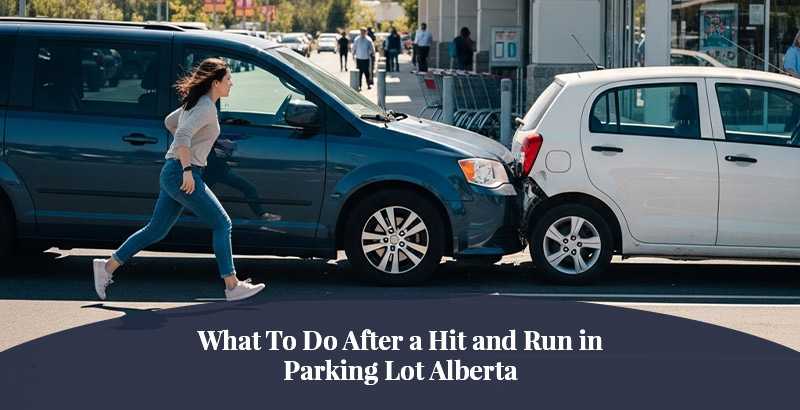You leisurely walk out of the grocery store, keys in hand, anticipating the familiar comfort of your vehicle. But as you approach, a knot of dread tightens in your stomach. There it is – a fresh dent, a scrape, or worse, a significant collision of your parked car. Your mind races: What happened? Who did this? And most importantly, what to do when someone hits and runs parked car Alberta?
It’s a frustrating and often enraging experience. Your car, an expensive investment and an integral part of your daily routine, has been damaged through no fault of your own. Whether it’s a minor fender collision or a larger impact, knowing the right steps to take is important to safeguard your rights, ease the claims process, and restore your vehicle to its pre-damage state. Let’s understand the steps to be taken when you find your car hit and run in parking lot.
Immediate Actions During a Hit and Run in Parking Lot
Your instinct may be one of anger or frustration, but it’s very important to remain calm and try to evaluate the situation logically. Here’s what you need to do immediately when you face a hit and run in Parking lot:
1. Document the Damage Clearly:
Before touching anything, meticulously document the damage. Use your smartphone or a camera to take clear, well-lit photographs from various angles. Capture close-ups of the damage and wider shots showing the damage in relation to the entire vehicle and its surroundings. Pay attention to:
- The extent and location of the damage (dents, scratches, broken lights, etc.).
- Any debris left at the scene might provide clues (paint chips, broken plastic).
- The location of your car in the parking lot.
- Any signs, security cameras, or possible witnesses in the area?
2. Search for a Note or Information:
Carefully check your car and the surrounding area for any notes left behind by the party at fault. This note may have their contact details, insurance information, or an apology. Even a simple note is good evidence.
3. Search for Witnesses:
Search the area for any possible witnesses who may have witnessed the accident happen. If there are nearby shops, go in and ask if anyone saw the crash or if they have security cameras that may have recorded it. Get their details if they have anything useful to say.
4. Call the Authorities (If Necessary):
In Alberta, reporting a collision to the police is only required in some provinces and only when the damage is major. In general, you ought to call the police if:
- The damage seems to be major (over a certain amount, which differs by province).
5. Do Not Move Your Car (Unless Directed):
Do not move your car out of place until you have fully investigated the scene and, if required, the police have come and completed their investigation. Moving your vehicle too soon may interfere with the investigation and even make it harder to process your insurance claim.
6. Managing the Insurance Claim Process
After you have secured the area and obtained initial information, the second important step is to know how the insurance claim process works. Whether you can file a claim if someone hits your parked vehicle in Alberta is usually possible, but the details will be based on your insurance policy and the nature of the accident.
Knowing Everything About a Hit and Run Charge in Alberta
Here are a few things you need to keep in mind while considering hit-and-run charges (penalties) in Alberta for accident coverage.
- Collision Coverage: This coverage will usually cover damages to your car caused by a collision, whether you are at fault or not. If you carry collision coverage, you should be able to make a claim against it for damage to your parked vehicle, even if the offending party is unknown (if it was a hit-and-run). You will most likely have to pay your deductible.
- Uninsured Automobile Coverage: This coverage is meant to cover you if you are in an accident with an uninsured driver or in a hit-and-run accident where the at-fault party cannot be determined. It can pay for repairing or replacing your vehicle, as well as any medical bills if you were hurt (though less probable when your car is stationary).
- Direct Compensation for Property Damage (DCPD): In a few provinces in Canada, including Alberta (presently Ontario, Quebec, Nova Scotia, New Brunswick, and Prince Edward Island), DCPD enables you to recover directly from your own insurance company for vehicle damages irrespective of fault. This is when the at-fault driver is known and covered in the same province.
How To Prevent Future Incidents
Although you cannot completely stop someone from colliding with your parked vehicle, there are a few measures you can take to reduce the risk:
- Choose Your Parking Spot Wisely: Opt for well-lit areas with more space around your vehicle. Avoid parking in tight or congested spots if possible.
- Park Away from High-Traffic Areas: Parking further away from entrances or exits might reduce the likelihood of being hit by a maneuvering vehicle.
- Be Mindful of Cart Return Areas: Stray shopping carts can cause significant damage. Park away from cart return areas if possible.
- Consider Buying a Dash Cam: Although designed for driving scenarios, a few dash cams come with a parking mode that will record an event if your vehicle is hit while parked.
Conclusion: Taking Control After the Impact
Noticing damage to your parked vehicle is always an unpleasant surprise. But knowing what to do when someone rear-ends your parked vehicle in Alberta, and moving quickly and systematically, you can deal with the situation successfully. Don’t forget to take photographs of the damage, take notes, call the authorities if required, and immediately report the incident to your insurance company. A small scratch or a major collision, having an idea of your rights and what to do will ensure your vehicle is fixed and back on the road with little hassle. If you are having trouble or have complicated legal issues, don’t hesitate to consult our Personal Injury Lawyer in Calgary, NKS Injury Legal, to get professional advice and assistance. Getting informed and ready is the best solution to regain control after the feared ding.

